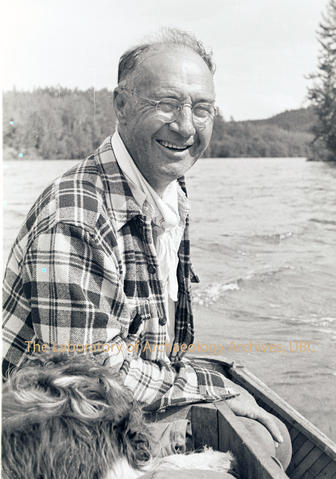
Zone du titre et de la mention de responsabilité
Titre propre
Dénomination générale des documents
- Document graphique
- Document textuel
- Document cartographique
Titre parallèle
Compléments du titre
Mentions de responsabilité du titre
Notes du titre
Niveau de description
Cote
Zone de l'édition
Mention d'édition
Mentions de responsabilité relatives à l'édition
Zone des précisions relatives à la catégorie de documents
Mention d'échelle (cartographique)
Mention de projection (cartographique)
Mention des coordonnées (cartographiques)
Mention d'échelle (architecturale)
Juridiction responsable et dénomination (philatélique)
Zone des dates de production
Date(s)
-
1903 - 2009; Predominant 1935 - 1953 (Production)
- Producteur
- John Henry "Jack" Sewell
Zone de description matérielle
Description matérielle
Zone de la collection
Titre propre de la collection
Titres parallèles de la collection
Compléments du titre de la collection
Mention de responsabilité relative à la collection
Numérotation à l'intérieur de la collection
Note sur la collection
Zone de la description archivistique
Nom du producteur
Notice biographique
John Henry "Jack" Sewell was born in Minnedosa, Manitoba in 1885. He was married to Alpha Welton, and they had six children: Gwen Vison, Bessie Heron, Margaret Vickburg, Shirley Millison, Bob Sewell, and John "Jackie" Sewell. Sewell worked as a private real estate and insurance agent in Saskatoon, SK until 1946. He then moved to Vanderhoof, BC in 1947 to live with his daughter Bessie Heron. Jack Sewell is primarily known in the Laboratory of Archaeology for his work as an amateur archaeologist in Northern Saskatchewan and Central British Columbia.
Sewell was a founding member of the Saskatoon Archaeological Society (est. 1935), where he served as secretary, treasurer, and president. His primarily research interests were in stone tool typologies and manufacturing techniques. He was a self-taught flint knapper and owned a large collection of stone tool belongings originating from the Saskatoon area and abroad. He bought and sold belongings and raw lithic materials from collectors and dealers located in Canada, the United States, and the United Kingdom. Through study and experimentation, Sewell created an unpublished manuscript called the Manufacture of Stone Tools, complete with diagrams and figures of different methodologies for knapping, drilling, and abrading lithic materials. During his lifetime, the British Museum, the National Museum of Canada, and the Provincial Museum of British Columbia exhibited examples of his tools and created films of his flint knapping techniques.
When Sewell retired to Vanderhoof, BC in 1947, he conducted self-directed archaeological surveys and surface collection along the Nechako-Stuart River drainage area. This work culminated in a 1950 report titled "Archaeological Remains in Central British Columbia" which was published in Anthropology in British Columbia, volume 1. In 1949, he collected surface finds while working as a hunting party cook at Cold Fish Lake, BC. In 1950 and 1952, Sewell was invited by Charles Borden to assist with the excavations of Chunlac Village and the survey of Tweedsmuir Park.
Jack Sewell died on October 1, 1953, in Vanderhoof, BC. He is buried with his wife in Saskatoon, SK.
Historique de la conservation
Portée et contenu
The Jack Sewell fonds contains the creator's unpublished manuscripts, field notes, and writings on North American stone tool typologies, the peopling of North America, flint knapping techniques, the archaeology of Central British Columbia, and the excavations at Chunlac Village. Sewell's writings, notes, receipts, and correspondence associated with the Saskatoon Archeological Society are also included within this fonds.
This fonds consists of 5 boxes and has been arranged into 6 series:
1 - Un-Published Field Notes and Writings
2 - Graphic Material
3 - Saskatoon Archaeological Society Materials
4 - Decontextualized Textual Materials.
5 - Correspondence
6 - Jack Sewell Fonds Access Records
Zone des notes
État de conservation
Source immédiate d'acquisition
Classement
Prior to LOA’s 2022 description, records had been physically rearranged from their original context. Many original file folders were empty, and their contents were rearranged by document type into temporary folders (e.g., an “Ephemera” folder). Original file folders used by Jack Sewell were titled: “Casualty Company of Canada,” “Archaeology 1937,” “Archaeology 1939,” “Archaeology Notes 1944,” “M.S.S. re 1947 + 1948 – Archaeological Search,” “Chinlac Village July 15 to August 23 – 1950,” “Archaeology 1952,” “Archaeology 1953,” “Old MSS + notes on the Archaeology of Central British Columbia,” “Vanderhoof Archaeology Misc.,” “Translations and Sketches,” “Archaeological Notes for Future Reference,” “Archaeology Old File,” “Paper for Provincial Museum,” “Provincial Museum Dr. Carl Dr. Munro,” “National Museum Ottawa Dr. Douglas Leechman,” “Vancouver Museum T.P.O. Menzies,” “M.E. Allen,” “Caribou Hide Indians Telegraph Creek and Cold Fish Lake,” “E. J. Case,” and “Personal.”
When possible, the original file folder title is used and the arrangement within the file was maintained. However, for decontextualized records, the archivist has physically rearranged the contents into three series based on the functions of the creator: unpublished manuscripts, field notes, and writings; correspondence; and Saskatoon Archaeological Society. All photographs which were decontextualized from their original arrangement are located in the graphic materials series. A fifth catch-all series was created for decontextualized notes, newspaper clippings, and receipts.
Langue des documents
Écriture des documents
Localisation des originaux
Disponibilité d'autres formats
Restrictions d'accès
Délais d'utilisation, de reproduction et de publication
Instruments de recherche
Éléments associés
Accroissements
Culturally sensitive note
Description physique
116 photographs.
37 negatives.
25 maps (within writings).
Identifiant(s) alternatif(s)
Previous fonds numbers
Black Volumes Index
Zone du numéro normalisé
Numéro normalisé
Mots-clés
Mots-clés - Noms
- John Henry "Jack" Sewell (Producteur)
- Charles E. Borden (Sujet)
- Wilson Duff (Sujet)
- Erna Clara von Engel-Baiersdorf (Sujet)
